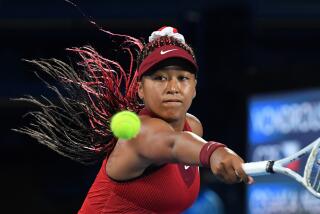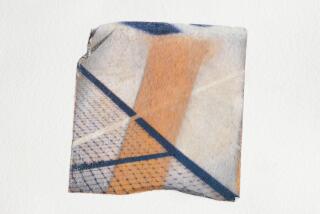He’s the Man That the Fan Loves to Hate
- Share via
“I hate funerals and would not attend my own if it could be avoided. But, it is well for every man to stop and reflect every now and then on the kind of mourners he is preparing for his final event.” --GOUVERNEUR MORRIS, Revolutionary patriot
John Patrick McEnroe Jr., the tennis player, may be a long way from his funeral, but a lot of people thought his tennis game was terminal. It had atrophied shockingly in a 6 1/2-month layoff. If it wasn’t dead, there was a rattle in its throat.
It was a day many people had been looking forward to like a kid to Christmas. Umpires, journalists, linesmen, opponents, the whole fabric of tennis yearned for the day when his serve no longer blistered, his forehand wobbled and his backhand netted.
Tennis could go back to being a gentleman’s game again and not a Bowery Boys sit-com. After all, it is a game that starts out at love and now it could go back to its tea-and-crumpets origins, where the royal box could be spared the kind of gutter language the lower classes use to express themselves.
McEnroe had lowered the elegant game to the level of mud wrestling. No self-respecting equerry would dare subject the Queen Mother to a McEnroe match. She would hear some perversions of the mother tongue Chaucer never dreamed of. Might as well take her to a porn house in Times Square.
It would be nice to have a Wimbledon final of “Lovely shot, Gene!” again, of silent, efficient Swedes or fun-loving but polite Aussies. No more guttersnipes to curdle the cream on the strawberries.
So, when McEnroe married a movie star and retired to Malibu to reflect on his options, tennis began, hopefully, to dig out like a family that has survived a tornado, to see what was left they could rebuild upon.
They had this pointy headed Czechoslovakian, a heavy-legged German kid and not much else. But matches could be played in library silence again. Tennis is not really a spectator sport, it is a kind of complicated tea dance. McEnroe made it seem like the semi-main at St. Nick’s or a dock fight in Marseilles.
When McEnroe didn’t even make Wimbledon and then got knocked out in the first round of the U.S. Open this year, tennis heaved a collective sigh of relief. The day it had been dreaming of seemed at hand.
The kind of mourners McEnroe had been training for his final event were about to throw their hats in the air. Throw a party. Uncork the champagne. Dance in the streets. Congratulate each other. The nightmare was over. Tennis was saved.
Or was it?
When McEnroe was eliminated, the U.S. Open degenerated into the Czechoslovakian Open. Four Czechs played in the two finals, which gave newspapers a field day with their “Hey, Czech This!” headlines and a chance to break out all their Czechpoints, Czechmates, bouncing Czechs, and similar puns.
Other publications were not so enchanted. When Ivan Lendl won, Sports Illustrated put his picture on the cover, labeling him “The Champion That Nobody Cares About.”
Inside, the magazine published a series of headless pictures of him, showing his shirts and suggesting that his wardrobe was the most interesting thing about him, that he played tennis with all the elan of a store window mannequin. The story pointed out he could empty a room faster than a loose anaconda or a smell of smoke, and said that when he took the court the aisles were so clogged with fleeing spectators it looked like the evacuation of Paris.
Lendl played the kind of robotized tennis that made you wonder where the dials were. He played such bloodless tennis that in the final against another Czech, so little known he was dubbed the blank Czech, it was reliably reported that only three people in America cared who won and only 11 would know.
Jimmy Durante used to sing, “You Know Darn Well I Can Do Without Broadway, but Can Broadway Do Without Me?”
Tennis won’t have to do without John McEnroe just yet. He showed up at the Volvo Tennis/Los Angeles tournament last week and, although it was not to be confused with the U.S. Open, it had some people who have been beating McEnroe lately. The crowds came out in numbers, probably in the hopes of seeing the shadow of John McEnroe humiliated by guys who couldn’t warm him up in the old days, the kind of people who slow down at freeway accidents or like chain-saw movies.
The McEnroe that showed up was no burnout. He was not the shell of a player the rumors had led the crowds to expect. He chewed out photographers, umpires, linesmen, referees, fans and opponents with equal skill and enthusiasm. He fought for every point, verbally and athletically.
If his tennis was a little ragged, his larynx was in Wimbledon form. He stood on the base line with those cat’s eyes of his, like a lion who sees a leaf moving in the bush across a clearing, and he whacked out opponents like Brad Gilbert while jawing with female fans, whom he called “low lifes.”
He kept up a running commentary to himself on the behavior of the ship of fools in the stands and violently contested all calls that went against him. Meanwhile, he was playing impeccable tennis.
It was vintage McEnroe. It called to mind Muhammad Ali systematically destroying some foe in his prime while keeping up a lively banter with the ringside seats. “Call this guy a contender”--bam!--”get me somebody”--whap! whap!--”who can fight.”
These verbal assaults are obviously as necessary to McEnroe’s game as a forehand volley. He seems to perform best with waves of hostility washing across him from the audience.
He basks in hate. He doesn’t play tennis, he provokes it. He stirs his own adrenaline, chokes his opponent’s choler--and then serenely plays his best tennis while affecting a scowl as black as a polar night.
He is not fooled by the crowd’s bared fangs. “People want to see me beaten in a match, until they remember that, if they do, they won’t see me the next day,” he explained in a postmatch press conference. “I think they want to see me the next day.”
At one point Saturday night, McEnroe walked over to a catcalling fan cheering for his opponent, Gilbert, and demanded: “What do you want to see tomorrow, an Edberg-Gilbert final or an Edberg-McEnroe?”
John McEnroe knew the answer. So does all tennis. They used to call Erich Von Stroheim, the movie villain, the man you love to hate. John McEnroe makes him look like Rebecca of Sunnybrook Farm.
McEnroe is training exactly the kind of mourners he wants--and tennis needs. Paying ones.
More to Read
Go beyond the scoreboard
Get the latest on L.A.'s teams in the daily Sports Report newsletter.
You may occasionally receive promotional content from the Los Angeles Times.










